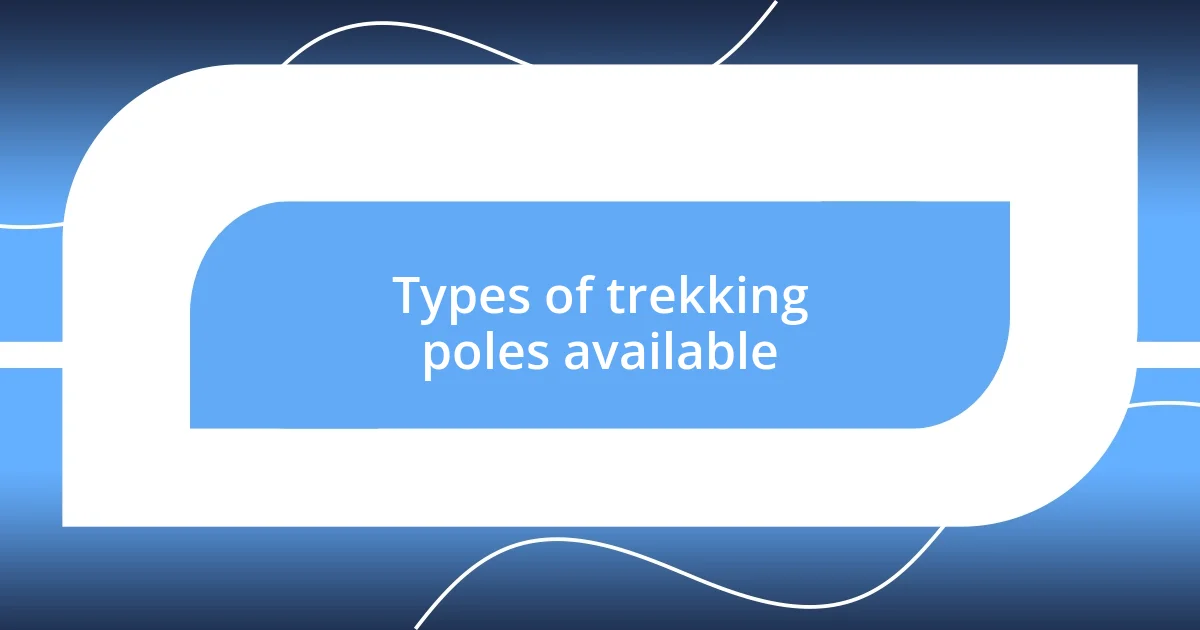Key takeaways:
- Trekking poles enhance stability, reduce knee impact, and create a meditative rhythm while hiking.
- Choosing the right type of trekking pole—collapsible, fixed-length, adjustable, aluminum, or carbon fiber—depends on personal preference and hiking style.
- Proper techniques and maintenance, including adjusting pole length and using wrist straps, significantly improve safety and hiking comfort.

Benefits of using trekking poles
Using trekking poles has transformed my hiking experience in ways I never expected. They provide remarkable stability, especially on those tricky, uneven terrains that can be a bit intimidating. When I found myself balancing over slippery rocks in a stream, I instinctively reached for my poles, feeling a rush of confidence that made all the difference.
One significant benefit I’ve noticed is the reduction of impact on my knees. After a long hike, my joints would often feel sore, but since incorporating trekking poles, I’ve felt a massive change. Isn’t it amazing how something so simple can spare your body the strain? I recall one particular descent where my knees would have typically taken a beating. Instead, I used my poles to maintain control, and to my surprise, I completed the hike feeling energized rather than exhausted.
Trekking poles also enhance my sense of rhythm while hiking, almost like a meditative practice. As I find a steady pace, I can concentrate on my breath and the beauty around me rather than the fatigue setting in. Have you ever felt that incredible connection to nature when everything seems to flow? That’s how I felt when my poles became extensions of my arms, guiding me along the path.

Types of trekking poles available
When it comes to trekking poles, you’ll find a few different types, each catering to specific needs and hiking styles. For example, collapsible poles are a favorite due to their portability. I still remember the first time I tried out a pair; they easily fit in my backpack, making them perfect for spontaneous adventures. On the other hand, fixed-length poles offer robustness and stability. I’ve hiked with others who swear by them for rocky terrain—there’s something reassuring about a solid, unyielding pole beneath you.
Adjustable poles are incredibly versatile, allowing you to change the length based on the terrain and your height. I can’t tell you how often this feature has come in handy, especially when transitioning from steep climbs to flat stretches. It’s like having custom-fit support for every situation. Finally, the material matters too. Aluminum poles are heavy-duty, while carbon fiber options are lightweight and absorb shock well. I once switched from aluminum to carbon fiber, and the ease felt almost magical—I was literally gliding along the trail!
Ultimately, your choice may depend on how you plan to use them, and personal preference plays a significant role. Will you be tackling rugged mountain trails frequently, or are you more of a leisurely nature walker? Each type of pole has its strengths, and finding the right one can enhance your outdoor experience tremendously.
| Type of Pole | Features |
|---|---|
| Collapsible | Portable, easy to store |
| Fixed-Length | Sturdy, reliable for rocky terrains |
| Adjustable | Versatile length for varying terrains |
| Material: Aluminum | Heavy-duty, sturdy |
| Material: Carbon Fiber | Lightweight, shock absorption |

Techniques for effective pole use
When using trekking poles, proper techniques can significantly enhance your hiking experience. I’ve learned that maintaining a natural arm movement is crucial. Instead of rigidly holding the poles, I let my arms swing freely—this mimics a walking rhythm that helps preserve energy during long hikes. It feels like dancing with the trail, where every step flows seamlessly.
Here are some key techniques to consider:
- Adjust the Pole Length: Set your poles to the right height before you start; this is especially important when negotiating steep slopes. I’ve found that adjusting them on the fly can lead to awkward movements and strain.
- Plant Poles Ahead: As I hike, I make a point of planting my poles slightly ahead of my body. This habit not only helps with balance but provides a reassuring stability that I’ve come to rely on during uncertain descents.
- Use the Wrist Straps: By utilizing the wrist straps, I can maintain a good grip without expending too much energy. I remember a day when I dropped one on a steep boulder—it took all my strength to scramble back down to pick it up! Now, those straps are non-negotiable for me.
- Engage Your Core: I find that keeping my core engaged while navigating tough terrain improves balance and control. It’s a surprising benefit that I hadn’t initially expected but has genuinely transformed my approach to hiking.
- Be Mindful of Your Surroundings: I’ve learned to be aware of my steps and adjust my pole placement according to the surface. Whether it’s a rocky trail or a muddy path, adapting my technique as I go has helped avoid slips and falls.
Mastering these techniques has truly enriched my trekking experience, allowing me to enjoy every moment on the trail with confidence.

Common mistakes to avoid
One common mistake I often see is hikers using poles that are simply too long or too short. I remember my first hike when I neglected to adjust my poles properly; I ended up straining my back and feeling awkward the entire time. It’s crucial to set them at the right height, allowing for a natural arm bend while walking. If the poles aren’t adjusted correctly, it can turn an enjoyable trek into a painful experience. Have you ever felt that tension creeping up your shoulders during a hike? It’s usually a sign that your poles are not set right!
Another error I cringe to recall is completely forgetting to engage the wrist straps. On one particularly challenging descent, I lost grip of my pole while trying to stabilize myself and nearly took a tumble! Those straps are designed to help you maintain control without excessive grip strength, so why not use them? It’s about preserving energy and ensuring safety. I now make it a habit to always adjust the straps before I start my hike.
Finally, one of the most overlooked aspects is how you plant your poles. I used to only focus on my feet and often found myself stumbling over uneven terrain. Then I realized the importance of planting my poles ahead of me, creating a rhythm that helped with balance. This small adjustment made my hikes feel more fluid and confident. Have you experienced the difference a steady pole can make on a tricky path? Embracing this technique transformed not just my hikes but my entire mindset towards them.

Maintaining your trekking poles
Maintaining your trekking poles is essential for their longevity and your hiking comfort. I’ve learned to wipe down the poles after every outing, especially if I’ve been on muddy or dusty trails. This simple act prevents dirt from grinding into the mechanisms, which can lead to wear and tear. Have you ever struggled with sticky, jammed mechanisms? I certainly have, and it’s frustrating!
I also make it a point to check the tips regularly. A worn-down tip can drastically affect traction, making steep descents feel much scarier than they should. I remember a time near a slippery ridge where I realized the metal tip on one of my poles was almost gone; my heart raced as I felt it slipping. Now, I carry spare tips in my pack, just in case!
Additionally, I’ve experienced how important it is to store my poles correctly. Leaving them in the car during extreme temperatures can weaken the materials. I once came back from a hike to find my poles had warped in the heat! So, I always ensure they’re kept in a cool, dry place between adventures. What about you? Have you ever noticed how proper storage can affect your gear’s performance? It’s one of those details that, once recognized, makes all the difference.

Personal experiences with trekking poles
Using trekking poles has been a game changer for me in navigating tough trails. I vividly recall a hike in the Rockies where the elevation gain was relentless. As I swung my poles rhythmically, I noticed an incredible difference in my endurance. The poles not only eased the pressure on my knees, they also became a source of stability on those steep switchbacks. Have you ever felt that exhilarating rush of confidence as you tackle a challenging ascent? For me, it was liberating.
On another occasion, I faced a sudden snowstorm while trekking in the Cascade Mountains. The visibility dropped, and my footing became uncertain. I instinctively dug my poles into the snow to create a sturdy base, which helped me maintain balance and find my footing. The sense of security they provided during that harrowing moment was astonishing. I still remember the adrenaline coursing through me as I maneuvered through those treacherous conditions. Have you ever relied on your gear to guide you through unexpected challenges? It was a reminder of how crucial the right tools can be.
Reflecting on my journey with trekking poles, I realize they’ve allowed me to explore trails I would have otherwise avoided. There was this breathtaking path along a cliffside that once intimidated me. Now, I feel emboldened to traverse it, trusting that my poles will catch me if I stumble. Isn’t it amazing how a simple piece of equipment can transform your hiking experience? Each outing reminds me that it’s not just about the destination but also the assurance and comfort that come with being prepared.














